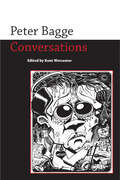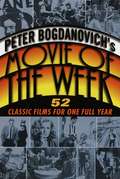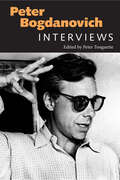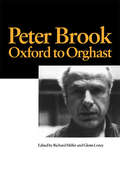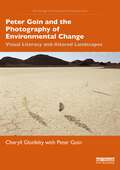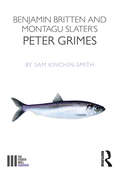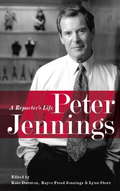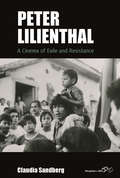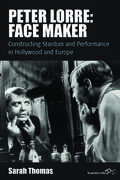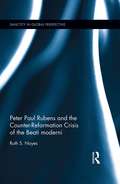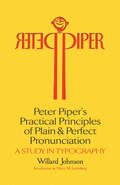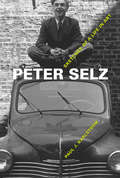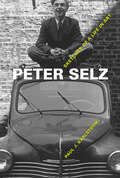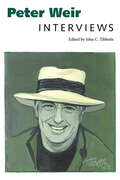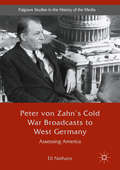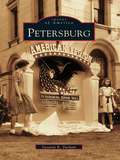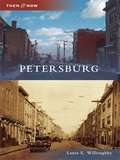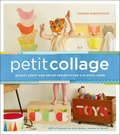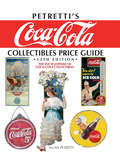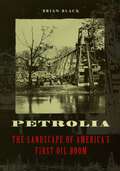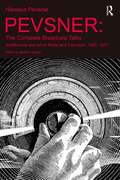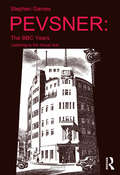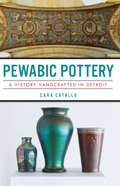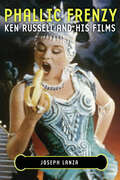- Table View
- List View
Peter Bagge: Conversations (Conversations with Comic Artists Series)
by Kent WorcesterFor fans of Peter Bagge (b. 1957) and his bracing satirical writing and drawing, this collection offers a perfect means to track how he describes his career choices, work habits, preoccupations, and comedic sensibility since the 1980s. Featuring a new interview and much previously unavailable material, this book delivers insightful, occasionally gossipy, sometimes funny, and often tart conversations. His career has intersected with the modern history of comics, from underground comix and indie comics to comics journalism and graphic nonfiction. Bagge's detailed, garrulous, and often grotesquely funny (and discomfiting) work harks back to the underground generation, recalling Robert Crumb and Gilbert Shelton, while also pointing forward to the emergence of alternative comics as a distinct genre. His signature series, the rawly humorous Hate (1990-1998) and his editorship (1983-1986) of the often outrageous Weirdo magazine, founded by Crumb, established Bagge as a leading voice in alternative comics, and his rude, wildly expressive cartooning makes him a counterpoint to the still introspection of recent literary graphic novels. In his career over three decades, Bagge has left his mark on various formats and genres, as a prolific cartoonist, an accomplished musician, and a sometime essayist, editor, and animator. While his creative output encompasses autobiographical comics, graphic nonfiction, magazine illustrations, gag cartoons, minicomics, political commentary, superhero parodies, comic strips, animated videos, and one-page humor pieces, Bagge stands out for creating continuity-based graphic stories that revolve around sharply defined, over-the-top fictional characters. Libertarians know him for his comics journalism, as his graphic biography of Margaret Sanger in 2013 reaches new audiences. While some have lazily branded Bagge as a grunge-era visual satirist, his creative restlessness and expanding body of work make it difficult to confine him within any single genre, cultural niche, or historical moment.
Peter Bogdanovich's Movie of the Week: 52 Classic Films for One Full Year
by Peter BogdanovichA FRONT-ROW SEAT TO A YEAR'S WORTH OF MUST-SEE FILMSDirector, producer, screenwriter, author, actor, and film critic, Peter Bogdanovich knows movies. Now, in this unique new book, he shares his passion with a connoisseur's insight and delight by inviting the reader to join him for a year at the movies--fifty-two weeks, fifty-two films, fifty-two reasons to watch. Which films does Peter Bogdanovich call . . ."The most hauntingly chilling, strangely prophetic science-fiction picture ever made."(You'll be treated to it on Halloween)"A scintillatingly directed comedy."(Discover it with someone you love on Valentine's Day)"A bittersweet human comedy of vintage genius [that] only becomes more precious as the years pass."(Ringing in the New Year with it is reason enough to celebrate)With recommendations specific to the seasons and holidays--from sparkling comedies, timeless musicals, landmark foreign films, powerful dramas and thrillers to legendary masterpieces and neglected treasures--Bogdanovich's eclectic cinematic calendar of classics, each available on video, each accompanied by an illuminating essay, and each followed by a list of tie-in recommendations, makes the perfect date for movielovers every week of the year.From the Trade Paperback edition.
Peter Bogdanovich: Interviews (Conversations with Filmmakers Series)
by Peter TonguetteBefore he was the Academy Award-nominated director of The Last Picture Show, Peter Bogdanovich (1939–2022) interviewed some of cinema's great masters: Orson Welles, Alfred Hitchcock, John Ford, and others. After becoming an acclaimed filmmaker himself, he gave countless interviews to the press about his own career. This volume collects thirteen of his best, most comprehensive, and most insightful interviews, many long out of print and several never before published in their entirety. They cover more than forty years of directing, with Bogdanovich talking candidly about his great triumphs, such as The Last Picture Show and What's Up, Doc?, and his overlooked gems, such as Daisy Miller and They All Laughed. Assembled by acclaimed critic Peter Tonguette, also author of a critical biography of Bogdanovich, these interviews demonstrate that Bogdanovich was not only one of America's finest filmmakers, but also one of its most eloquent when discussing film and his own remarkable movies.
Peter Brook: Oxford To Orghast To India
by R. Helfer G. LoneyPeter Brook is known internationally as a theatre visionary, and a daring experimenter on the cutting-edge of performance and production. This book concentrates on Brook's early years, and his innovative achievements in opera, television, film, and the theatre. His productions are viewed separately, in chronological order, suggesting Brook's developing and changing interests. The authors include thought-provoking interviews with Brook (and with numerous outstanding artists who have worked with him) and bring to the reader penetrating critiques of Brook's theories and practices as a man of the theatre.
Peter Goin and the Photography of Environmental Change: Visual Literacy and Altered Landscapes (Routledge Environmental Humanities)
by Peter Goin Cheryll GlotfeltyPeter Goin and the Photography of Environmental Change narrates the forty-year quest of award-winning and internationally exhibited contemporary photographer Peter Goin to document human-altered landscapes across America and beyond. It is a collaborative work between an artist and a literary critic, a retrospective of an accomplished environmental photographer, and an innovative education in visual reading. Enduring howling wind, pounding rain, and blistering sun, Goin bears witness to radioactive landscapes, abandoned mines, simulated swamps, rechanneled rivers, controlled burns, overgrown ruins, industrialized agriculture, shrinking reservoirs, feral spaces in the city, architected wilderness, sacred wastelands, contested borderlands, and more. Based on more than seventy hours of taped interviews with the artist spanning over a decade, trailblazing ecocritic Cheryll Glotfelty narrates the arc of Goin's career, sharing excerpts from their conversations that reveal his brilliant mind and piquant personality while situating his work within the broader context of environmental thinkers. This beautifully illustrated volume, with 200 images in color and black-and-white showcasing Goin’s work, will be a fascinating and insightful read for upper-level students, academics, and researchers in photography, environmental history and culture, landscape studies, and environmental humanities.
Peter Grimes
by Sam Kinchin-Smithã `Who can turn skies back and begin again?' -Peter ã This book contends that Peter Grimes, widely regarded as one of the greatest and most influential operas of the 20th century, is also one of the British theatre's finest `lost' plays. Seeking to liberate Britten and Slater's work from the blinkered traditions of theatre and opera criticism, Sam Kinchin-Smith poses two questions: If an opera was created like a play, and can be staged as a play, is it a play? If a portion of its success and influence is the product of this newly identified theatrical engine, is it then a great play? The answers involve Wagner and W.G. Sebald, George Crabbe and Complicite, Akenfield and Twin Peaks. Challenging long-established narratives of post-war theatre history, this book makes a compelling case for why practitioners and scholars of performance ought to pay more attention to Britten and Slater's achievement - a milestone of unconventional English modernism - and perhaps to other operatic masterpieces too.
Peter Jennings: A Reporter's Life
by Lynn Sherr Kate Darnton Kayce Freed JenningsPeter Jennings was the sole anchor of ABC's World News Tonight from 1983 until his death from cancer in 2005. For many Americans, he was the voice and face that gave shape and meaning to every day's news. But who was Peter Jennings really? In this absorbing biography, readers will get to know Jennings through the memories of his friends, family, competitors, colleagues, and interview subjects. Their stories are full of surprises. Jennings, we learn, was a high school dropout who spent the rest of his life in pursuit of knowledge. He traveled the world in search of stories, a notebook perpetually thrust through his back belt loop. In his front pocket, he carried a miniature copy of the Constitution, a testament to his love for the United States; a Canadian by birth, Jennings acquired American citizenship in 2003.Peter Jennings was a celebrity, of course-a dashingly handsome and elegant man, famous for his ability to charm women and world leaders alike-but in these pages he is remembered as a loyal friend and a devoted family man, who loved nothing more than to canoe with his kids and listen to jazz with his friends in the Hamptons. Not that he was the relaxing sort. Jennings was a task-master, who ripped other reporters' pieces to shreds, forcing them to rewrite from the ground up. He was a perfectionist, too, who drove his fellow correspondents crazy with his ad-libbed questions on the air. It was all about standards. Throughout his life, Peter Jennings was driven by a passion to seek the truth and convey that truth accurately, simply, cleanly, and elegantly to his American audience. He was our voice.
Peter Lilienthal: A Cinema of Exile and Resistance (Film Europa #25)
by Claudia SandbergBest known for his 1979 film David, Peter Lilienthal was an unusual figure within postwar filmmaking circles. A child refugee from Nazi Germany who grew up in Uruguay, he was uniquely situated at the crossroads of German, Jewish, and Latin American cultures: while his work emerged from West German auteur filmmaking, his films bore the unmistakable imprints of Jewish thought and the militant character of New Latin American cinema. Peter Lilienthal is the first comprehensive study of Lilienthal’s life and career, highlighting the distinctively cross-cultural and transnational dimensions of his oeuvre, and exploring his role as an early exemplar of a more vibrant, inclusive European film culture.
Peter Lorre: Face Maker
by Sarah ThomasPeter Lorre described himself as merely a 'face maker'. His own negative attitude also characterizes traditional perspectives which position Lorre as a tragic figure within film history: the promising European artist reduced to a Hollywood gimmick, unable to escape the murderous image of his role in Fritz Lang's M. This book shows that the life of Peter Lorre cannot be reduced to a series of simplistic oppositions. It reveals that, despite the limitations of his macabre star image, Lorre's screen performances were highly ambitious, and the terms of his employment were rarely restrictive. Lorre's career was a complex negotiation between transnational identity, Hollywood filmmaking practices, the ownership of star images and the mechanics of screen performance.
Peter Paul Rubens and the Counter-Reformation Crisis of the Beati moderni (Sanctity in Global Perspective)
by Ruth S. NoyesPeter Paul Rubens and the Crisis of the Beati Moderni takes up the question of the issues involved in the formation of recent saints - or Beati moderni (modern Blesseds) as they were called - by the Jesuits and Oratorians in the new environment of increased strictures and censorship that developed after the Council of Trent with respect to legal canonization procedures and cultic devotion to the saints. Ruth Noyes focuses particularly on how the new regulations pertained to the creation of emerging cults of those not yet canonized, the so-called Beati moderni, such as Jesuit founders Francis Xavier and Ignatius Loyola, and Filippo Neri, founder of the Oratorians. Centrally involved in the book is the question of the fate and meaning of the two altarpiece paintings commissioned by the Oratorians from Peter Paul Rubens. The Congregation rejected his first altarpiece because it too specifically identified Filippo Neri as a cult figure to be venerated (before his actual canonization) and thus was caught up in the politics of cult formation and the papacy’s desire to control such pre-canonization cults. The book demonstrates that Rubens' second altarpiece, although less overtly depicting Neri as a saint, was if anything more radical in the claims it made for him. Peter Paul Rubens and the Crisis of the Beati Moderni offers the first comparative study of Jesuit and Oratorian images of their respective would-be saints, and the controversy they ignited across Church hierarchies. It is also the first work to examine provocative Philippine imagery and demonstrate how its bold promotion specifically triggered the first wave of curial censure in 1602.
Peter Piper's Practical Principles of Plain and Perfect Pronunciation: A Study in Typography
by Harry Miller Lydenberg Willard JohnsonAndrew Airpump ask'd his Aunt her ailment, Davy Dolldrum dream'd he drove a Dragon, Jumping Jackey jeer'd a Jesting Juggler, and Rory Rumpus rode a raw-bon'd Race-horse among other antics in this antique alphabet of tongue twisters.Originally published in 1836, this charming collection of whimsical rhymes was redesigned 100 years later by some of the twentieth century's most celebrated typographers. The artists volunteered their services and worked independently of each other, resulting in a captivating pastiche in which the verses are rendered in a variety of typefaces and accompanied by woodcuts, line drawings, and other black-and-white illustrations.
Peter Selz: Sketches of a Life in Art
by Paul J. Karlstrom Ann KarlstromThis absorbing biography, often conveyed through Peter Selz's own words, traces the journey of a Jewish-German immigrant from Hitler's Munich to the United States and on to an important career as a pioneer historian of modern art. Paul J. Karlstrom illuminates key historical and cultural events of the twentieth-century as he describes Selz's extraordinary career--from Chicago's Institute of Design (New Bauhaus), to New York's Museum of Modern Art during the transformative 1960s, and as founding director of the University Art Museum at UC Berkeley. Karlstrom sheds light on the controversial viewpoints that at times isolated Selz from his colleagues but nonetheless affirmed his conviction that significant art was always an expression of deep human experience. The book also links Selz's long life story--featuring close relationships with such major art figures as Mark Rothko, Dore Ashton, Willem de Kooning, Sam Francis, and Christo--with his personal commitment to political engagement.
Peter Selz: Sketches of a Life in Art
by Paul J. KarlstromThis absorbing biography, often conveyed through Peter Selz’s own words, traces the journey of a Jewish-German immigrant from Hitler’s Munich to the United States and on to an important career as a pioneer historian of modern art. Paul J. Karlstrom illuminates key historical and cultural events of the twentieth-century as he describes Selz’s extraordinary career—from Chicago’s Institute of Design (New Bauhaus), to New York’s Museum of Modern Art during the transformative 1960s, and as founding director of the University Art Museum at UC Berkeley. Karlstrom sheds light on the controversial viewpoints that at times isolated Selz from his colleagues but nonetheless affirmed his conviction that significant art was always an expression of deep human experience. The book also links Selz’s long life story—featuring close relationships with such major art figures as Mark Rothko, Dore Ashton, Willem de Kooning, Sam Francis, and Christo—with his personal commitment to political engagement.
Peter Weir: Interviews (Conversations with Filmmakers Series)
by John C. TibbettsPeter Weir: Interviews is the first volume of interviews to be published on the esteemed Australian director. Although Weir (b. 1944) has acquired a reputation of being guarded about his life and work, these interviews by archivists, journalists, historians, and colleagues reveal him to be a most amiable and forthcoming subject. He talks about “the precious desperation of the art, the madness, the willingness to experiment” in all his films; the adaptation process from novel to film, when he tells a scriptwriter, “I'm going to eat your script; it's going to be part of my blood!”; and his self-assessment as “merely a jester, with cap and bells, going from court to court.” He is encouraged, even provoked to tell his own story, from his childhood in a Sydney suburb in the 1950s, to his apprenticeship in the Australian television industry in the 1960s, his preparations to shoot his first features in the early 1970s, his international celebrity in Australia and Hollywood. An extensive new interview details his current plans for a new film. Interviews discuss Weir's diverse and impressive range of work—his earlier films Picnic at Hanging Rock, The Last Wave, Gallipoli, and The Year of Living Dangerously, as well as Academy Award-nominated Witness, Dead Poets Society, Green Card, The Truman Show, and Master and Commander. This book confirms that the trajectory of Weir's life and work parallels and embodies Australia's own quest to define and express a historical and cultural identity.
Peter von Zahn's Cold War Broadcasts to West Germany
by Eli NathansThis book examines the pioneering radio broadcasts and television documentaries about the United States made in the 1950s by the influential West German journalist Peter von Zahn. Part intellectual biography, part analysis of significant debates in West Germany, part study of an intensive encounter with the United States, the book helps explain the transformation of postwar West Germany. As a soldier in the Wehrmacht in World War II, Zahn held the militantly elitist views typical of young men in Germany's educated middle class. He reconsidered these positions in his postwar broadcasts. At the same time he coldly assessed the capacity of the United States to win the Cold War. His broadcasts examined McCarthyism, the African-American civil rights movement, and numerous aspects of American culture and politics. Zahn's broadcasts were one important voice in West German debates about the defects and virtues of modern democratic societies and especially of the United States, debates whose intensity reflected recent German experiences with the failure of the Weimar Republic and with Nazism. Zahn's analyses of the United States remain startlingly relevant today.
Petersburg
by Suzanne K. DurhamThe colorful history of Petersburg is a story rife with tragedy and perseverance. Petersburg, a city 25 miles south of Richmond, was devastated by the effects of the Civil War. By 1915, the city had rebuilt itself into a vital business center with 25,000 citizens-equally populated by whites and African Americans. The city had a military base, deep water port and shipyard, and was considered well equipped for competition in national agricultural and manufacturing markets. The numerous museums and historical sites in Petersburg continue to draw thousands of visitors annually.Now for the first time, Petersburg's history is shown through the photographs of William E. Lum Jr.-the city's predominant photographer, c. 1925-1950. Lum's photography illustrates the social, business, and personal lives of Petersburg's citizens. His first published collection, these images hold crisp detail from the eras of the Great Depression and World War II, including Camp Lee, Virginia State College, the merchants on North Sycamore Street, carnivals, and football games-to name a few.
Petersburg (Then and Now)
by Laura E. WilloughbyThe postcard collection included in this volume portrays Petersburg as both a progressive 20th century city and as a community with deep historical roots. Landmarks such as Old Blandford Church, the Hustings Courthouse, and the United States Custom House and Post Office (now City Hall) are highlighted in this book. Petersburg's Civil War history is also strongly represented with images of the Crater and surrounding battlefield and fortifications, as well as monuments, memorials, and museums that sprang up after the war.
Petit Collage
by Lorena SiminovichFrom the beloved design brand for nurseries, playrooms, and every space in between, Petit Collage shows you how to make 25 of their bestselling paper and wooden accessories for your home. Customize toy chests, create cheerful name plaques, build bunny clocks, and more, with artist and owner Lorena Siminovich. Breaking down each project with simple, illustrated step-by-step instructions, Siminovich presents easy tips on how to personalize the Petit Collage signature style with your child's favorite colors and patterns. All you need are rubber stamps, paper, scissors, and the provided project templates to create a contemporary space filled with bright and distinctive décor. Whether you're looking for unique paper toys or vibrant namesake prints, Petit Collage's whimsical craft projects will inspire your children to put their little touch and big imagination into your family home.
Petretti's Coca-Cola Collectibles Price Guide: The Encyclopedia of Coca-Cola Collectibles (Petretti's Coca-cola Collectibles Price Guide Ser.)
by Allan PetrettiChapter by colorful chapter of Coca-Cola calendars, serving trays, bottles, signs, vintage advertisements, toys, coolers, dispensers and countless other items representing the foremost name in soda pop collectibles await you, in this new edition of the superior Coca-Cola collectibles identification and values reference.
Petroleum and Marine Technology Information Guide: A bibliographic sourcebook and directory of services
by J. Hutcheon A. Myers S. Oue B. Rodden J. WhittickFirst published in 1981 as the Offshore Information Guide this guide to information sources has been hailed internationally as an indispensable handbook for the oil, gas and marine industries.
Petrolia: The Landscape of America's First Oil Boom (Creating the North American Landscape)
by Brian BlackWinner of the Paul H. Giddens Prize in Oil History from Oil Heritage Region, Inc. In Petrolia, Brian Black offers a geographical and social history of a region that was not only the site of America's first oil boom but was also the world's largest oil producer between 1859 and 1873. Against the background of the growing demand for petroleum throughout and immediately following the Civil War, Black describes Oil Creek Valley's descent into environmental hell. Known as "Petrolia," the region charged the popular imagination with its nearly overnight transition from agriculture to industry. But so unrestrained were these early efforts at oil drilling, Black writes, that "the landscape came to be viewed only as an instrument out of which one could extract crude." In a very short time, Petrolia was a ruined place—environmentally, economically, and to some extent even culturally. Black gives historical detail and analysis to account for this transformation.
Pevsner: Architecture and Art on Radio and Television, 1945-1977
by Stephen GamesThis book brings together the surviving texts of the 113 talks on art and architecture that we know of, given by the art historian Sir Nikolaus Pevsner on radio and television between 1945--1977. It includes the seven texts of the 1955 Reith Lectures in their original broadcast form, as well as lectures that Pevsner gave in German (for the BBC in London and RIAS in Berlin) and on the radio in New Zealand. These talks are important as an example of the attempt by the BBC in particular to provide intellectual programming for the mass population. The talks are important for what they reveal about changing tastes in the treatment of the arts as a broadcast topic, as well as offering a case study of the development of one particular historian's approach to a subject that was gaining ground in universities as a direct result of his popularisation of it. They show what topics were thought to be central to the artistic agenda in the mid-years of the last century, whether from an academic or journalistic perspective, and reveal the mode and manner of academic engagement with the public over the period. Forty-six of these talks were published in 2002, on the centenary of Pevsner's birth, in a trade edition. At the time, his reputation as an active force in architectural thinking had long been eclipsed and interest in him had waned. Since then, there has been a turn-around in tastes and Pevsner's role within his chosen field is now being actively studied and discussed by a new generation for whom he is central to an understanding of the 20th century. There is therefore a real need for this book. In addition to containing twice the number of talks as the previous volume, it is supplemented with explanatory introductions, footnotes and citations. It also reveals, as far as this is possible, alternative versions of Pevsner’s texts, as they appeared at different stages in the original production process. As such, this edition can be relied on by academics as scholarly and
Pevsner: Listening to the Visual Arts
by Stephen GamesPevsner: The BBC Years gives the first full account of Sir Nikolaus Pevsner’s engagement with the BBC at a time when both were the dominant institutions in their own fields -- Pevsner as the most persuasive figure in architecture and art history, the BBC as the country's sole broadcaster. A German emigré, Pevsner was not at first trusted to speak on the air, and was only invited to appear at the very end of the war, in spite of his growing eminence in academia and publishing. With the arrival of the Third Programme in 1946, however, he quickly became a broadcasting celebrity, and one whom senior BBC figures regarded as essential and novel listening. Pevsner: The BBC Years looks at the sudden rise in Pevsner’s standing at the BBC, at what he was admired for, and at the circumstances surrounding his being commissioned, in the mid-1950s, to give the first series of Reith Lectures on an arts subject -- the relationship between visual expression and national identity. The book explains the roles played by Geoffrey Grigson, Basil Taylor, Anna Kallin and Leonie Cohn in advancing Pevsner's BBC career, analyses the literary character of his broadcasting, and considers the function of his talks as an extension of European belletrism. It also demonstrates the significance of his concurrent editorship of the King Penguin series of books. In addition, Pevsner: The BBC Years documents the unravelling of Pevsner's reputation. It shows how he was caught between changing fashions in media culture and damaged by doubts about the safety of his ideas, both within the BBC and, externally, among British conservatives who found him too radical and American radicals who found him too conservative. In Pevsner: The BBC Years, correspondence from the BBC’s archives provides a case study of scholarly thought being exposed to independent scrutiny -- a process with lessons for today.
Pewabic Pottery: A History Handcrafted in Detroit (Landmarks)
by Cara CatalloAt the height of America’s Arts and Crafts movement, Detroit neighbors Horace J. Caulkins and Mary Chase Perry pooled their talents together to found Pewabic Pottery. With modest beginnings in 1903, Pewabic transformed from a rented stable in Brush Park to an English Tudor building on East Jefferson Avenue, where it has operated since 1907. Today, the iconic enterprise continues Perry’s dedication to handcrafted ceramics and remains known for its iridescent glaze on everything from vessels and architectural tiles to ecclesiastical installations in churches across the country, including the Basilica of the National Shrine of the Immaculate Conception. Author Cara Catallo illuminates the story behind one of the oldest American handcrafted pottery traditions.
Phallic Frenzy: Ken Russell and His Films
by Joseph LanzaA biography of director Ken Russell that details the wild ideas, surreal moments, personal faith, and cavalcade of colorful personalities surrounding this eccentric filmmaker--on and off the set. Best known for the acclaimed movies Altered States, The Devils, Gothic, The Music Lovers, Tommy, and Women in Love, Russell redefined cinema in the 1960s, 70s and 80s, working with magnetic actors like Jack Nicholson, Michael Caine, Ann-Margret, William Hurt, Gabriel Byrne, and Vanessa Redgrave. Moments of Russell's career are highlighted in this intimate biography, including how creative differences between Russell and producer Robert Stigwood stopped production of a movie version of Evita, how he creatively staged the love duet between Faust and Helen over a bowl of pasta in the opera Mephistopheles, and how Alan Bates and Oliver Reed compared their penis size for the nude wrestling scene in Women in Love.
